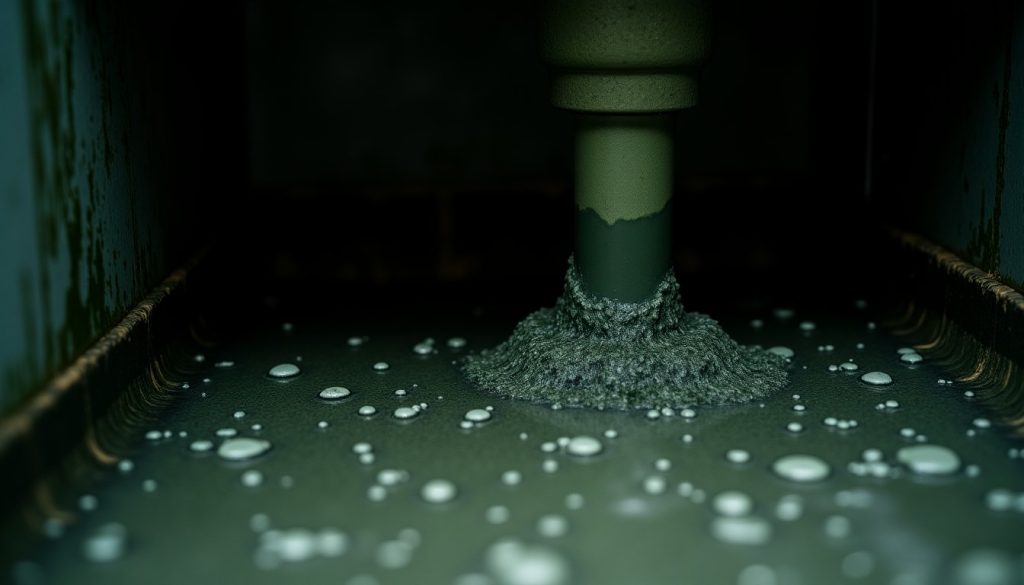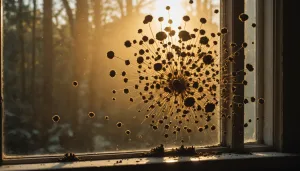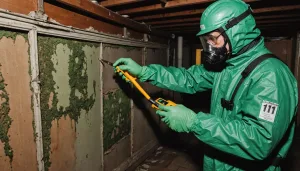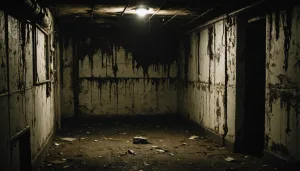Black mold and mildew are both types of fungi that thrive in damp, humid conditions, but their appearance and characteristics differ significantly, making it crucial for homeowners to accurately identify them for proper mold removal. Recognizing these differences is the first step in addressing any potential infestation effectively.
Visual Differences:
One of the most straightforward ways to differentiate between black mold and mildew is through visual inspection. Mildew typically appears as a gray or white powdery film that develops on surfaces, primarily affecting plant leaves, fabrics, and paper. It usually starts as small, yellow spots, which gradually turn to brown and then to black if left untreated. On the other hand, black mold appears as a dark black or greenish-black stain and is usually slimy or fuzzy in texture. It often develops in places that have been consistently moist, such as shower stalls, under sinks, or anywhere water damage has occurred.
Odor and Smell:
Another identifying characteristic involves odor. Black mold is infamous for its musty, earthy odor, which can often be a telltale sign even before visible signs emerge. This pungent smell is a clear indicator that black mold growth needs urgent attention. Mildew, meanwhile, doesn’t have quite as strong an odor but can still produce a slightly unpleasant scent.
Growth Patterns:
The growth patterns of these fungi are also distinct. Mildew grows in a flat pattern and typically remains on the surface, making it generally easier to clean and remove. Meanwhile, black mold tends to penetrate and spread within the material it’s occupying, often requiring more intensive mold remedy efforts to fully eradicate its presence.
| Characteristic | Black Mold | Mildew |
| Color | Black or greenish-black | Gray or white |
| Texture | Slimy or fuzzy | Powdery or fluffy |
| Odor | Musty, intense | Mild, less distinct |
| Growth Depth | Deep, into structures | Surface-level |
Environmental Factors:
While both types of fungi thrive in damp environments, their preferences in terms of specific conditions can be slightly different. Black mold tends to flourish in conditions where there is high humidity or where water damage has occurred and not been adequately dried or repaired. It often requires a more significant moisture presence to establish compared to mildew, which can grow even in slightly damp conditions and on surfaces that don’t always remain wet.
Understanding these identifying characteristics can significantly enhance one’s ability to correctly determine which kind of fungal growth they are dealing with. With this knowledge, appropriate mold removal techniques can be employed to effectively tackle and remediate the problem while minimizing the risk of health complications and structural damage.
health risks associated with exposure
Exposure to black mold and mildew can lead to various health concerns, and understanding these risks is essential for maintaining a healthy living environment. The potential health effects can vary depending on the type of mold or mildew present, the duration of exposure, and the individual’s sensitivity or allergy levels.
1. Allergic Reactions:
– Individuals exposed to either black mold or mildew may experience allergic reactions. Common symptoms include sneezing, runny nose, red or itchy eyes, and skin rashes. These symptoms can be more severe for those with pre-existing allergies or asthma, as these individuals are typically more sensitive to fungal spores.
2. Respiratory Issues:
– Inhaling mold spores can aggravate asthma and other chronic respiratory conditions. Black mold, in particular, is known for releasing mycotoxins, which can lead to breathing difficulties, persistent coughing, and wheezing in healthy individuals and exacerbated symptoms in those with respiratory illnesses.
3. Neurological Symptoms:
– Though rarer, prolonged exposure to high levels of mold, especially black mold, can potentially lead to neurological issues. Some individuals report headaches, dizziness, memory problems, or even mood swings due to toxic exposure, though scientific research is ongoing in this area to fully establish these connections.
4. Compromised Immune System:
– People with weakened immune systems, such as those undergoing chemotherapy or living with autoimmune diseases, are at increased risk. Exposure to mold spores can lead to more serious infections in these individuals, requiring immediate medical attention.
5. Irritation and Infection:
– Black mold in particular can cause irritation not only to the respiratory system but also to the skin when touched. In some cases, fungal infections can occur if mold spores enter the body through cuts or abrasions in the skin.
It is essential for individuals who suspect mold or mildew exposure related health issues to seek medical consultation promptly. To minimize these risks and ensure effective mold removal, individuals should consider employing professional mold remedy services that can thoroughly address and eliminate mold colonies, preventing recurrence. Being mindful of these health risks reinforces the importance of addressing potential mold problems without delay to ensure a safe and healthy home environment.
causes and growth conditions
Both black mold and mildew thrive in environments that support their growth, often linked to certain common conditions that create optimal circumstances for these fungi to flourish. Recognizing these causes and growth conditions is pivotal for effective mold removal and prevention.
Moisture is the main driver for both black mold and mildew proliferation. These fungi thrive in areas with high humidity and dampness. Black mold in particular is notorious for growing in areas that have experienced water damage or prolonged exposure to moisture, such as leaky roofs, pipes, and poorly ventilated bathrooms. Unlike mildew, which can develop in slightly damp conditions, black mold requires a more significant and sustained moisture presence. It’s not uncommon to find black mold in places where water tends to pool or where moisture is trapped, such as basements, attics, and beneath leaky sinks.
Temperature also plays a critical role in the growth of these fungi. Most molds, including black mold and mildew, grow best in warm temperatures. While mildew can develop in a broader range of temperatures, black mold prefers environments where the temperature stays relatively consistent and warm, which accelerates its growth and spread.
Lack of ventilation is another crucial factor that contributes to the growth of both black mold and mildew. Inadequate airflow in homes allows moisture to linger and creates stale air—a perfect breeding ground for fungi. Rooms like bathrooms, kitchens, and laundry areas are particularly susceptible because they are naturally high in humidity and often lack sufficient ventilation.
Furthermore, organic material serves as a food source for black mold and mildew. Materials such as wood, cardboard, and fabrics provide the necessary nutrients for these organisms to thrive. Black mold, in particular, can be more invasive as it tends to penetrate deeper into these materials, making mold remedy efforts more challenging.
Understanding these growth conditions underscores the importance of maintaining a dry and well-ventilated environment, which is crucial for preventing the growth and spread of mold and mildew in homes. Ensuring proper ventilation, controlling humidity levels, and quickly addressing any water leaks or dampness can significantly reduce the likelihood of mold infestation and ensure a healthier living space.
prevention strategies and solutions
To effectively prevent black mold and mildew, adopting a proactive approach is key. Moisture control lies at the heart of prevention strategies. Since both black mold and mildew thrive in damp environments, keeping your home as dry as possible should be the primary goal. This can be achieved by addressing leaks swiftly, whether they’re from roofs, pipes, or other sources, and ensuring these areas are repaired promptly to prevent mold remedy from becoming a necessity.
Investing in a good dehumidifier can significantly help in areas where humidity is consistently high. Basements, attics, and bathrooms, all notorious for retaining moisture, greatly benefit from dehumidifiers to maintain an environment that doesn’t favor mold growth. Regularly opening windows and doors, using exhaust fans especially in kitchens and bathrooms, and ensuring proper air circulation are practical steps in enhancing ventilation. These measures reduce humidity and discourage the damp, stagnant conditions mold thrives in.
Preventing mold growth also involves paying attention to temperature control. Keeping indoor temperatures at a moderate level discourages drastic fluctuations that can promote moisture accumulation on surfaces, thus deterring mold infestation. In colder months, using insulation to reduce condensation on walls and windows can also be beneficial.
Cleaning routines are another crucial preventative measure. Regular cleaning—especially in areas prone to dampness—prevents the buildup of spores and potential mold colonies. Focus on scrubbing showers, tubs, and other wet surfaces weekly with mildew-resistant products. Products containing mold inhibitors can be particularly effective as they help curb mold growth before it can take root.
Implementing preventive barriers such as mold-resistant drywall or paint in areas prone to dampness can also be an effective strategy. These materials are designed to withstand high humidity levels longer, preventing mold from establishing itself.
Finally, regular inspections of particular home areas vulnerable to water issues, such as basements, attics, and crawl spaces, ensure that early signs of mold are spotted and addressed before they become a full-blown problem. Addressing these early can limit the scope of mold removal efforts needed later on.
Remember, prevention is always easier and less costly than having to deal with full-scale mold removal or remediation. By making these strategies part of your regular maintenance routine, you can maintain a safe, mold-free living environment, reducing health risks and structural damage to your home.
cleaning and remediation techniques
Cleaning and removing mold and mildew require distinct approaches due to their differing characteristics and growth patterns. Tackling mildew is generally simpler since it grows on surfaces, which means it can be scrubbed away using household cleaners. Start by mixing a solution of water and mild detergent; then use a soft brush or cloth to remove the mildew from the surface. For more stubborn areas, consider using a mixture of 50% water and 50% white vinegar, an effective natural remedy. After cleaning, thoroughly dry the affected area to prevent further growth.
Addressing black mold, however, demands more caution and often requires specialized mold removal techniques due to its ability to penetrate and damage building materials. For small areas of black mold (less than 10 square feet), you can use a mixture of water and detergent, or in tougher cases, a commercial mold remover or a bleach solution of one part bleach to ten parts water. Always wear protective gear, including gloves, goggles, and a mask, to prevent inhalation of spores.
If the mold covers a larger area, has penetrated drywall, or if there are persistent water issues, it is advisable to consult professional mold remediation services. These experts have the tools and expertise to effectively tackle the problem without spreading spores or causing additional health risks. They can remove deeply embedded mold, repair damaged areas, and sanitize affected spaces to prevent future outbreaks.
Regardless of the type of mold, ensure the area is completely dry after cleaning to limit recurrence. Dehumidifiers, fans, and heating systems can aid in eliminating moisture. Be vigilant about addressing any leaks immediately to prevent mold from finding a new foothold. Implementing these cleaning and remediation strategies can help ensure a mold-free environment, reducing potential health hazards and maintaining structural integrity.
In conclusion, understanding the key differences between black mold and mildew, their health risks, causes, and optimal growth conditions is crucial for effective management and prevention. By identifying these fungi correctly and employing the right strategies for cleaning, remediation, and prevention, homeowners can protect their health and maintain their property. Proactive measures, including moisture control and regular inspections, alongside prompt action at the first signs of mold growth, ensure a safe and healthy living environment, free from the detrimental effects of mold and mildew.






Skupka is a chain of consignment stores продать playstation. We buy and sell used and new electronics, household appliances in St. Petersburg and the Leningrad Region.